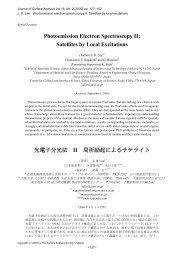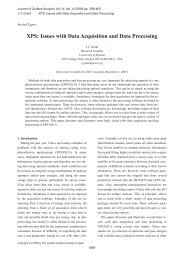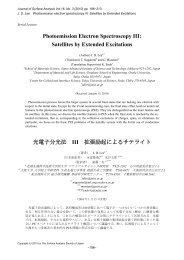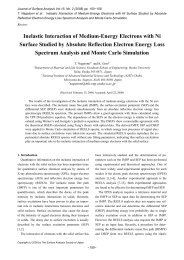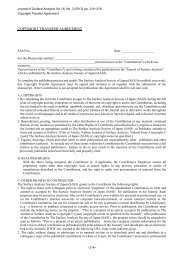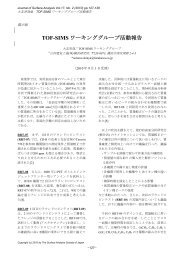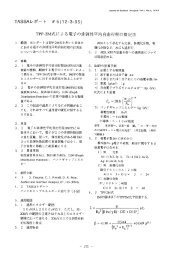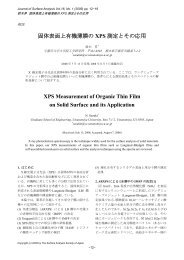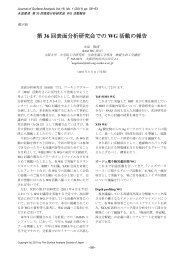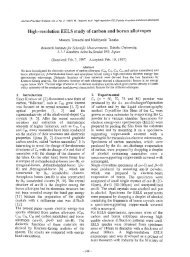Invetigation of Hydrophobic Properties of PSII-modified EVOH ...
Invetigation of Hydrophobic Properties of PSII-modified EVOH ...
Invetigation of Hydrophobic Properties of PSII-modified EVOH ...
You also want an ePaper? Increase the reach of your titles
YUMPU automatically turns print PDFs into web optimized ePapers that Google loves.
Journal <strong>of</strong> Surface Analysis, Vol.12 No.2 (2005); Y. H. Lee, et al., Investigation <strong>of</strong> <strong>Hydrophobic</strong> …….<strong>Invetigation</strong> <strong>of</strong> <strong>Hydrophobic</strong> <strong>Properties</strong> <strong>of</strong> <strong>PSII</strong>-<strong>modified</strong> <strong>EVOH</strong>,LLDPE, and PET FilmsY. H. Lee * , S. H. Han, and Y. S. KimAdvanced Analysis Center, Korea Institute <strong>of</strong> Science & Technology, Seoul 136-791, Korea*yhlee@kist.re.krReceived 4 October 2004; Accepted 10 January 2005The industrial use <strong>of</strong> ethylene-vinyl alcohol copolymer (<strong>EVOH</strong>), linear low density polyethylene(LLDPE), and poly(ethylene terephthalate) (PET) films are limited because it is changed by moisture.The plasma source ion implantation (<strong>PSII</strong>) technique with CF 4 or CH 4 gas was used for <strong>EVOH</strong>, LLDPE,and PET films to improve the surface hydrophobic properties and oxygen barrier properties. Theirtreated surfaces were characterized to understand the mechanism <strong>of</strong> modification processes by X-rayphotoelectron spectrometry (XPS). Variables examined in implantation were ion energy (0-10 keV)and ion species. The <strong>modified</strong> surfaces <strong>of</strong> <strong>EVOH</strong>, LLDPE, and PET were characterized to check therelevance <strong>of</strong> the modification and aging on the polymer surface. <strong>PSII</strong> treated polymer was found tohave more hydrophobic property than plasma treatment. The hydrophobic properties <strong>of</strong> polymer filmswere greatly enhanced after a CF 4 -<strong>PSII</strong> treatment as evidenced by an increased contact angle. XPSprovided the evidence that hydrophobic properties <strong>of</strong> the <strong>modified</strong> polymer surfaces are related to thefluorine-containing functional groups, especially CF 2 and CF 3 groups.INTRODUCTIONIn the polymer world, PE and PET havediverse applications due to abundant supply, goodchemical resistance, high impact strength, and lowcost. They are widely used in packagingapplications directly or in the form <strong>of</strong> laminateswith other polymers, aluminum foil, paper, etc. [1].Generally, they provide good processability, lowmanufacturing costs and high mechanicalproperties for packaging application; however theyhave low barrier properties to oxygen, CO 2 , organicvapors, and flavors [2].The use <strong>of</strong> <strong>EVOH</strong> copolymers is also limited,because <strong>EVOH</strong> copolymers are greatly affected bywater [3]. The barrier properties deteriorate as thewater molecules interfere with polymerself-association via inter- and intra-molecularhydrogen bonding. This results in the reduction <strong>of</strong>inter-chain cohesion and mechanical integrity, anincrease in the fractional free volume <strong>of</strong> thepolymer (plasticization effect), and enhancement <strong>of</strong>the permeation through polymer packages [4].To modify the moisture plasticizaton property<strong>of</strong> the <strong>EVOH</strong> film, some treatments have beendeveloped [5]. Recently, the modifications <strong>of</strong>polymer surfaces were attempted to improve thehydrophobic properties <strong>of</strong> surfaces withoutaffecting the bulk properties <strong>of</strong> the polymers [6-8].Recently, Lee et al. investigated the use <strong>of</strong>plasma source ion implantation (<strong>PSII</strong>) formodification <strong>of</strong> polymeric materials [9]. It wasfound that the <strong>PSII</strong> process was very effective inmaking the surface hydrophilic or hydrophobic andproduced a stable surface layer.In this paper, a <strong>PSII</strong> treatment was used tomodify the surface <strong>of</strong> <strong>EVOH</strong> copolymer , LLDPE,and PET films. It was hypothesized that thehydrophobic and barrier properties <strong>of</strong> the polymerswould be improved by substituting fluorine forhydroxyl group on the polymer surface. Thephysical properties and aging behavior <strong>of</strong><strong>PSII</strong>-treated polymer films were studied by acombination <strong>of</strong> water contact angle measurementand X-ray photoelectron spectroscopy (XPS). And,O 2 permeability was measured to investigate thefilm barrier properties.
Journal <strong>of</strong> Surface Analysis, Vol.12 No.2 (2005); Y. H. Lee, et al., Investigation <strong>of</strong> <strong>Hydrophobic</strong> …….Water contact angl e [degree]130120110100908070Plasma- 1 kV- 5 kV- 10 kVc/s4000350030002500200015001000500(a) Before treatmentO=C-OC-OC-H, C-C601301200 4 8 12 16 20 24 28Agi ng ti me [day]016001400294 292 290 288 286 284 282Binding Energy (eV)(b) <strong>PSII</strong> ( - 1 kV)C-H, C-C280278Water contact angl e [degree]Water contact angl e [degree]1101009080706013012011010090807060Plasma- 1 kV- 5 kV- 10 kV0 4 8 12 16 20 24 28Agi ng ti me [day]plasma- 1 kV- 5 kV- 10 kV0 4 8 12 16 20 24 28Agi ng ti me [day]Fig. 1 Water contact angle <strong>of</strong> CF 4 <strong>PSII</strong> treated (a)<strong>EVOH</strong> (b) LLDPE and (c) PET film with varyingion energy as a function <strong>of</strong> aging time. Treatmentcondition <strong>of</strong> plasma is: 0 kV, 1 mTorr, and 200 W.contact angle was taken as average values <strong>of</strong> threedrops on the polymer surface. The dispersion force(γ d s ) and the polar force (γ p s ) values <strong>of</strong> the polymersurface were calculated from the contact anglevalues <strong>of</strong> water(polar) and diiodomethane(non-polar) [14].Table 1 lists the water and diiodomethanecontact angles and surface energies <strong>of</strong> polymersbefore and after plasma source ion implantation(<strong>PSII</strong>). After CF 4 -<strong>PSII</strong> treatments, the watercontact angle values <strong>of</strong> <strong>EVOH</strong>, LLDPE, and PETc/12001000s8006004002000296CF3294CF2O=C-CF2292CFO=C-OC=OC-CF2 / C-O290 288 286 284Binding Energy (eV)Fig. 2 XPS spectrum <strong>of</strong> PET films (a) untreated and(b) treated by <strong>PSII</strong>markedly increased to θ = 105°, 123°, and θ = 103°,respectively, indicating an increase in surfacehydrophobicity by <strong>PSII</strong>. As expected, CF 4 as awork gas produced more hydrophobic surface thanCH 4 plasma due to the incorporation <strong>of</strong> morehydrophobic groups such as CF, CF 2 , and CF 3 ontothe polymer surface. Table 1 includes the surfaceenergies calculated from the water anddiiodomethane contact angles <strong>of</strong> the polymerstreated with CF 4 -<strong>PSII</strong>. After the treatments, a sharpdecrease in the polar surface tension (γ p s) wasobserved, and the dispersive, nonpolar part (γ d s ) <strong>of</strong>the surface tension also decreased.Figure 1 shows changes in the hydrophobicproperties <strong>of</strong> <strong>PSII</strong>-treated <strong>EVOH</strong>, LLDPE, and PETfilms with ion energy and aging. These propertieschanged with increasing energy <strong>of</strong> the implantedions. The contact angle <strong>of</strong> CF 4 <strong>PSII</strong>-treated filmsmarkedly increased, the largest among others at theion energy level <strong>of</strong> –5 keV for <strong>EVOH</strong> and –1 keVfor LLDPE and PET, and leveled <strong>of</strong>f after 7 days <strong>of</strong>aging at all energy levels applied.The contact angle remaining relatively282280278
Journal <strong>of</strong> Surface Analysis, Vol.12 No.2 (2005); Y. H. Lee, et al., Investigation <strong>of</strong> <strong>Hydrophobic</strong> …….Table 2 Deconvolution components <strong>of</strong> C 1s signalsC-CO=C-CFC-CF2 / C=O C-F O=C-O CF22C-OCF3(284.6) (286.5) (287.9) (288.5) (289.0) (291.0)(292.0)(293.0)<strong>EVOH</strong> Untreated 65.7 34..3Plasma 29.9 29.9 10.7 14.1 7.2 2.8<strong>PSII</strong>(-5kV) 36.7 27.7 10.5 8.3 12.9 4.0LLDPE Untreated 92.6 3.6Plasma 57.4 14.8 10.8 5.0 9.0 3.0<strong>PSII</strong>(-1kV) 52.4 12.9 8.2 7.9 14.4 2.1PET Untreated 61.2 19.0 18.8Plasma 36.4 15.5 6.3 19.0 7.9 8.1 4.4 2.5<strong>PSII</strong>(-1kV) 36.9 16.3 6.2 18.6 5.4 10.8 4.0 1.8Table 3 Oxygen permeability <strong>of</strong> <strong>PSII</strong> treated <strong>EVOH</strong>films with various %RH.0(%RH)O2 permeability a50 (%RH) 93(%RH)Untreated 0.628 0.780 5.654<strong>PSII</strong>treated0.0571 0.228 0.514a Unit <strong>of</strong> permeability is in 10 -15 l⏐m/m 2 ⏐s⏐Pa ;unchanged during the 28 days period <strong>of</strong> agingindicates that there were no appreciable changes in the<strong>modified</strong> surface properties <strong>of</strong> the film due to storage.It is noted that the surface hydrophobic propertiesincreased owing to the replacement <strong>of</strong> C-H bonds orOH groups with C-F bonds or the incorporation <strong>of</strong> CF 2and CF 3 groups onto the polymer surface after CF 4treatment.Figure 2 shows the C 1s core-level spectra <strong>of</strong> PETsurfaces that received a <strong>PSII</strong> treatment. The surveyspectra reveal that the CF 4 -<strong>PSII</strong> treatment increasedthe fluorine concentration and decreased the carbonand oxygen concentrations on the PET surface. Thedeconvoluted C 1s spectra indicate that CF 4 -treatedPET has several fluorine functionalities on the surface,compared to peaks obtained from the untreated PET.The results from the survey and the C 1s spectra areconsistent with the contact angle data that theCF 4 -<strong>PSII</strong> treated surface <strong>of</strong> PET is more hydrophobicthan that <strong>of</strong> the untreated PET.Table 2 lists the percentage <strong>of</strong> each carbonfunctional group presented in the spectrum. Therewere some changes such as a decrease in height ataround 284.6 eV and 286.6 eV for <strong>EVOH</strong> and PET,and an introduction <strong>of</strong> new functional groups in C1speak <strong>of</strong> XPS spectra for the <strong>modified</strong> polymer surfaces.The results show that the <strong>PSII</strong> method produced moreCF 2 and CF 3 functional groups than the plasmatreatment. Especially, CF 4 -<strong>PSII</strong> treatment for <strong>EVOH</strong>with –5 keV provided more CF 2 and CF 3 groups on thepolymer surface, resulting in a more hydrophobicsurface. From the XPS results, it was found that CF 2and CF 3 groups contributed more significantly to thehydrophobic surface than CF or C-H bond. And, theXPS result is also in good agreement with the contactangle measurement.Oxygen barrier properties <strong>of</strong> <strong>PSII</strong>-treated <strong>EVOH</strong>films can be estimated by measuring gas permeabilityat various % RH. Oxygen permeabilities <strong>of</strong> untreatedand <strong>PSII</strong>-treated <strong>EVOH</strong> films are compared in Table 3.The <strong>PSII</strong>-treated <strong>EVOH</strong> films protected oxygen gasalmost ten times higher than untreated films.Therefore, <strong>PSII</strong> modification with CF 4 for <strong>EVOH</strong>films greatly improved oxygen barrier properties onthe polymer surface.CONCLUSIONS<strong>EVOH</strong>, LLDPE, and PET films were <strong>modified</strong> toimprove the hydrophobic properties by <strong>PSII</strong> treatmentwith CF 4 and CH 4 gases. <strong>PSII</strong> with CF 4 gas was foundto be a promising modification method whichgenerates hydrophobic surfaces by producing morefluorine-containing functional groups on the surfaces.The contact angle results showed that the CF 4 <strong>PSII</strong>
Journal <strong>of</strong> Surface Analysis, Vol.12 No.2 (2005); Y. H. Lee, et al., Investigation <strong>of</strong> <strong>Hydrophobic</strong> …….treatment provided polymer films with morehydrophobic surfaces than the conventional plasmamethod. As a function <strong>of</strong> aging time, the <strong>modified</strong>polymer surfaces maintained the good hydrophobicproperties after the CF 4 <strong>PSII</strong> treatment. The <strong>modified</strong>surfaces were characterized by XPS. XPS dataindicate the formation <strong>of</strong> CF, CF 2 , and CF 3 groups onthe polymer surface after CF 4 treatment and a goodcorrelation between the percentage <strong>of</strong> CF 2 and CF 3groups and the high contact angle values <strong>of</strong> the treatedsurfaces. CF 4 -<strong>PSII</strong> treated <strong>EVOH</strong> had much betteroxygen barrier properties than the untreated sample.REFERENCES[1] D. S. Bag, S. N. Ghosh and S. Maiti, Eur. Polym. J.,34, 855 (1998).[2] J. P. G. Villaluenga and B. Seoane, Polymer 39,3955 (1998).[3] S. Aucejo, C.Marco and R. Gavara, J. Appl. Sci.,74, 1201 (1999).[4] Shafiur Rahman, M. Handbook <strong>of</strong> FoodPreservation; Marcel Pekker, Inc.: New York,Chap. 23, 1999.[5] J. M. Lagaron, E. Gimenez, R. Garara and J. Saura,J. Polymer, 42, 9531 (2001).[6] J. Meichner, M. Nitschke, R. Rochotzki and Zemer,Surf. Coat. Technol., 74, 227 (1995).[7] J. C. Caro, U. Lappan and K. Lunkwitz, Surf. Coat.Technol., 74, 1192 (1995).[8] A. Hollander, R. Wilken and J. Behnischi, Surf.Coat. Technol., 116, 788 (1999).[9] Y. H. Lee, S. H. Han, J. H. Lee, J. H. Yoon, H. E.Lin and K. A. Kim, J. Vac. Sci. Technol. 16, 1710(1998).[10] S. H. Han, H. D. Kim, Y. H. Lee, J. H. Lee and S.Kim, Surf. Coat. Technol., 93, 254 (1996).[11] S. Mahl, M. Neumann, V. Schlett and A.Baalmaun, Surf. and Interface Anal., 26, 204(1998).[12] T. Yahi and A. E. Pavlath, J. Appl. Polym. Sci., 32,215 (1984).[13] G. H. Shin, Y. H. Lee, J. S. Lee, Y. S. Kim, W. S.Choi, and H. J. Park, J. Agric. Food Chem., 50,4608 (2002).[14] D. K. Owens and R. C. Wendt, J. Appl. Polym.Sci., 13, 1741 (1969).[15] D. K. Owens, J. Appl. Polym. Sci., 14, 1725(1970).[16] ASTM D3985-81, Standard test method foroxygen gas transmission rate through plastic filmand sheeting using a coulometric sensor, In ASTMBook <strong>of</strong> Standards, American society for TestingMaterials, Philadelpia, PA, 1981.



